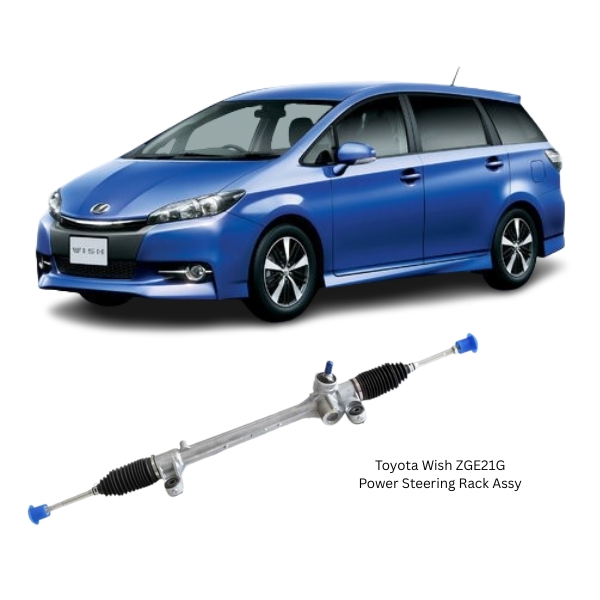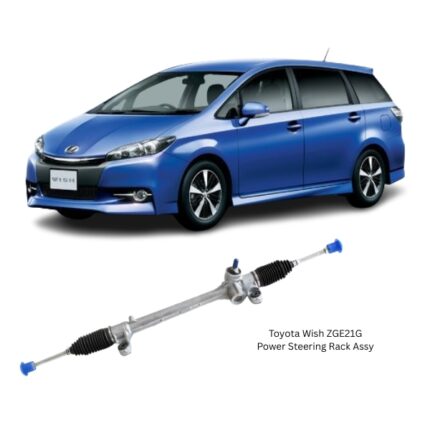Get Toyota Wish ZGE21G Power Steering Rack Assy 45510-68021 in Kenya
The Power Steering Rack Assembly is a vital component of a vehicle’s steering system, designed to convert the rotational motion of the steering wheel into linear motion needed to turn the wheels. By integrating hydraulic or electric power assist mechanisms, it significantly reduces the physical effort required by the driver while ensuring precise, responsive, and smooth steering control.
Found in both passenger and commercial vehicles, the power steering rack plays a critical role in driver comfort, maneuverability, and safety. Whether navigating tight turns, executing parking maneuvers, or maintaining lane control at highway speeds, the power steering rack provides consistent and reliable performance under varying driving conditions.
Primary Function and Operation
The Power Steering Rack Assembly is part of the rack-and-pinion steering system. Its primary function is to:
-
Translate steering wheel rotation into lateral wheel movement
-
Assist in steering effort using hydraulic or electric power
-
Maintain steering alignment and response
-
Ensure stability during cornering, braking, and rough terrain driving
In hydraulic systems, the rack receives pressurized fluid from a power steering pump, which helps push the internal piston left or right in response to steering input. In electric systems, the assist comes from an electric motor coupled with sensors that interpret driver input and vehicle speed.
Key Components
A complete power steering rack assembly is a precision-engineered unit that includes several interdependent components, each performing a specific function:
-
Rack Housing
A durable metal casing—usually aluminum or cast steel—that encloses the inner components and supports the assembly’s mounting to the vehicle frame. -
Rack Gear (Rack Bar)
A linear gear shaft that meshes with the pinion gear. It slides left or right to steer the wheels in response to driver input. -
Pinion Gear
A small gear at the base of the steering column that rotates with the steering wheel and engages the rack gear to produce lateral movement. -
Tie Rods (Inner and Outer)
Connect the ends of the rack gear to the steering knuckles, transmitting the linear motion to the front wheels. -
Hydraulic Piston (in hydraulic systems)
Located inside the rack, this piston receives fluid pressure on one side or the other to aid in movement. -
Seals and Bushings
Prevent fluid leaks and provide smooth rack movement while reducing noise and friction. -
Boots (Bellows)
Protective rubber covers that shield the inner tie rods and rack ends from dust, moisture, and debris. -
Input Shaft
Links the steering column to the pinion gear and transmits torque from the steering wheel.
Some power steering racks also feature variable assist, speed sensors, or electronic control modules in modern electric systems for adaptive steering behavior.
Performance Characteristics
-
Enhanced Steering Response: Allows for sharp, accurate steering with minimal play or delay.
-
Reduced Driver Fatigue: Minimizes the physical force needed for turning, especially at low speeds or when parking.
-
Consistent Assist: Maintains assistance regardless of terrain, weather, or load conditions.
-
Safety and Control: Improves vehicle control during evasive maneuvers or emergency braking.
Types of Power Steering Rack Assemblies
There are primarily two types of power steering rack systems:
-
Hydraulic Power Steering (HPS)
Uses pressurized hydraulic fluid delivered by a pump (belt-driven by the engine) to assist in steering force. Known for reliability and responsiveness. -
Electric Power Steering (EPS)
Utilizes an electric motor mounted on the rack or column to provide assist based on sensor input. Common in newer vehicles due to efficiency and reduced engine load.
Both types can include variable assist features that adapt steering feel based on speed, load, or road condition.
Common Signs of Failure
Like all mechanical components, the power steering rack is subject to wear and damage over time, especially under heavy usage or in harsh environments. Common symptoms of a failing rack include:
-
Hard or stiff steering
-
Fluid leaks beneath the front end
-
Uneven or excessive tire wear
-
Clunking or knocking noises during steering
-
Steering wheel play or looseness
-
Vehicle pulling to one side
-
Visible damage to dust boots or seals
Failure to address steering rack issues can lead to compromised handling, unsafe driving, and further damage to suspension components.
Installation Guidelines
Replacing a power steering rack assembly requires mechanical skill and precision. It is recommended to be performed by trained technicians. General steps include:
-
Lift and Support Vehicle
Ensure safety by properly lifting the front of the vehicle and securing it on jack stands. -
Disconnect Steering Linkages
Remove tie rods from the steering knuckles and disconnect the input shaft from the steering column. -
Drain Hydraulic Fluid (if applicable)
Disconnect and plug hydraulic lines to prevent fluid spillage. -
Remove Mounting Bolts
Detach the rack from the subframe or crossmember. -
Install New Rack
Position the new unit and secure it with the correct torque specifications. -
Reconnect Linkages and Hoses
Install tie rods, input shaft, and hydraulic or electronic connections. -
Refill and Bleed System
Fill with new power steering fluid (for HPS systems) and bleed air from the system. -
Perform Alignment
A full wheel alignment is necessary to restore proper steering geometry.
Maintenance and Care
While power steering racks are typically low-maintenance, regular checks can prevent major issues:
-
Inspect Fluid Levels: Low fluid may indicate a leak or worn seals.
-
Check Boot Condition: Torn bellows can allow contaminants in.
-
Listen for Noises: Unusual sounds during turning can signal internal wear.
-
Monitor Steering Feel: Gradual stiffness or looseness may suggest deterioration.
Hydraulic systems require periodic fluid replacement, while electric systems may need sensor calibration or software updates as part of service routines.
Benefits of a High-Quality Replacement Rack
-
Restores Precise Steering
Eliminates sloppiness or vagueness in wheel response. -
Improves Driving Safety
Maintains consistent control during all driving conditions. -
Extends Tire Life
Ensures even tire wear through proper steering alignment. -
Reduces Driver Fatigue
Enhances comfort, particularly in urban or high-traffic environments. -
Quiet and Smooth Operation
Reduces vibrations, knocks, and excessive play in the steering system.
Follow us on Facebook for more parts.





Reviews
Clear filtersThere are no reviews yet.